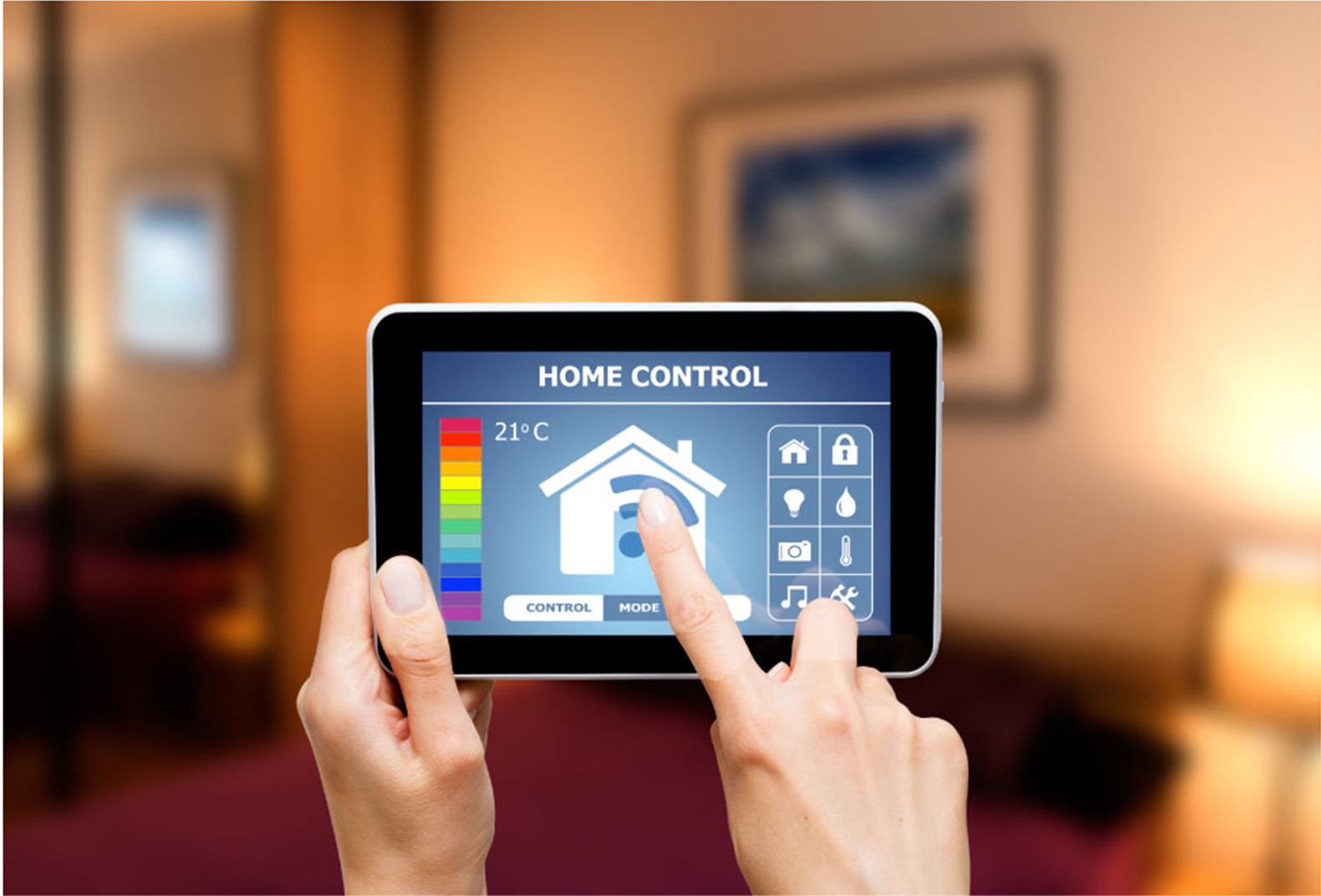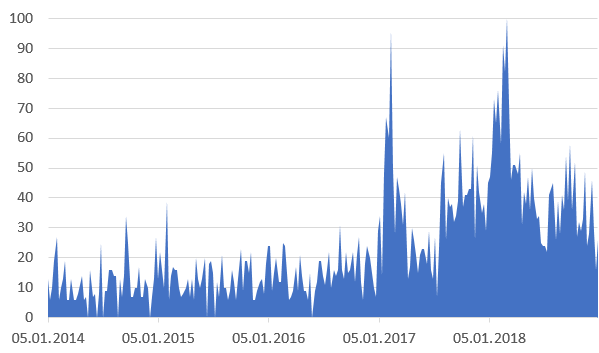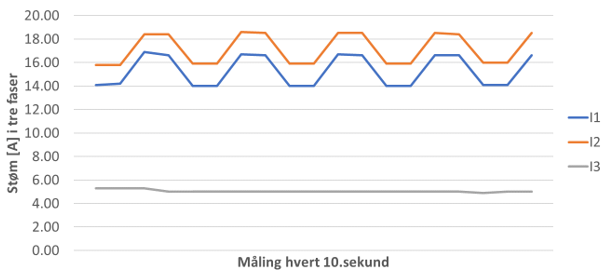Coauthors: Karoline Ingebrigtsen og Bendik Nybakk Torsæter
Smart meters, AMS, energy meters, digital electricity meters. We have many names for the things we love. There’s no doubt that we’re curious about electricity meters.

The figure below shows Google results for relative frequencies for the search words “electricity meters” over the last five years, with peaks in February 2017 and March 2018. In this blog I would like to tell you more about smart (AMS) meters and what a HAN port is, how you as a consumer can benefit, and the research work SINTEF is conducting as part of the project ENERGYTICS.
Digitalisation of the power industry is changing the customer’s role in the energy system
The internet and digital technologies have undergone massive development in recent decades, and the global economy is becoming increasingly digital. Technological progress is preparing the way for a raft of new opportunities, but also raises challenges linked to new business models within the traditional value chains.
The power industry is now in the middle of this upheaval, with the challenges and opportunities it brings with it. A key factor here is a better awareness of the customer’s role and the opportunities for innovation created by better synergies in the shaping of tomorrow’s flexible energy system.
A smart meter in every home creates many opportunities
The Norwegian Water Resources and Energy Directorate(NVE) has taken an important step by agreeing that all Norwegian homes should have Advanced Metering Systems (AMS), or smart meters, installed by 1 January 2019. The meters alone represent a major and demanding investment, both for the grid companies and society as a whole.
Above all else, the meters are regarded as a tool to facilitate the automatic calculation and reading of electricity consumption at one hour’s resolution. However, they also offer a number of auxiliary functions. This opens for other benefits achieved using real-time data, and the opportunity to construct effective databases for historical key data from the distribution grid.
These data will enable the provision of better grounds for decision-making linked to operations and investment. This is crucial for the development of a smarter, more flexible and more eco-friendly energy system, and ensures that investment in the grid is implemented as effectively and optimally as possible for the benefit of society as a whole.
For you as a customer, an AMS meter can mean more automatic meter readings so that you don’t have to send these in yourself. You can also obtain more information about your own electricity consumption.
What is a HAN port, and what can it be used for?
All new electricity meters installed in Norwegian homes are fitted with an output terminal called a HAN port (Home Area Network). You can connect to the HAN port yourself. You have to contact your grid company in order to open your HAN port. Data retrieved from your HAN port belongs to you. This means that if a grid company or any other third party wants to retrieve data from your HAN port, it has to enter into an agreement with you.

There are more than 45 companies currently supplying equipment used to connect to HAN ports. A HAN port enables you to monitor your consumption and other parameters such as voltage. If you are generating electricity using solar cells, you can also monitor your own production. If you have controllable (smart) heat pumps, electric car chargers or similar, you can coordinate these with your consumption data from the HAN and electricity prices as a means of reducing your consumption during peak load periods when electricity is expensive.
Your HAN port can help you save money
Everyone in Norway pays both grid tariffs, and for the electricity they use. Grid tariffs are paid to the grid company to which you are physically connected for the use, operation and maintenance of the electricity grid. You pay for your electricity consumption to your electricity supplier (whom you can choose).
There are plans to introduce new tariff structures in 2021, which will probably entail higher prices at peak load periods. In response to this, you can save money on your electricity bill in two ways:
- by moving your consumption to periods when the load on the grid is lower
- lower electricity price
More information about changes to tariff structures can be found here
Utilisation of your AMS meter depends on the type of HAN port equipment
According to the Norwegian Electrotechnical Committee (NEK), the volume of data that emerges from your HAN port depends on the equipment you have installed. As a minimum requirement, most suppliers present your energy consumption in kWh (with one-hour’s resolution), and your power output in W (with second’s/minute’s resolution).
The figure below shows power output consumption for a 24-hour period in September in a household with measurements taken every two seconds. This provides information about when consumption is high. In combination with information about consumption related to controllable electrical appliances in the house, these data can form a basis for the reduction of consumption during periods when the electricity price is high.
The power system utilises three phases (conductors) for electricity transfer, and many households are connected to all three phases, with uneven load allocations. Smaller households and flats are commonly only connected to one of the three phases.
It is now easy for you to see whether the three phases in your house exhibit uneven load allocations (see the figure above). The figure shows electricity in three phases, in which the first exhibits a much lower load allocation than the two others. The ideal situation is to allocate approximately the same load to all three phases. The figure has been put together based on data from the HAN port.
What do the grid companies do with the data retrieved from your smart meter?
The grid companies also obtain data from your smart electricity meter (but not via the HAN port), and will use these to provide their customers with better services. For example, the meter sends a message to the grid company when it loses current during a power cut, so that the failure can be identified and repaired more quickly. In this way the grid company can notify you about power cuts, instead of you having to call to inform them.
Data from the electricity meter can also be used to identify areas where the voltage is too high or too low, and thus help the grid companies assign priorities in terms of grid expansion or other initiatives. They also provide an opportunity to identify and repair earth-faults more quickly.
The grid company receives smart meter data at a lower resolution (up to every 15 minutes, but usually every hour) than you as a customer can obtain from your HAN port. The reason for this is mainly due to limitations in data transfer capacity.
Smart meters provide an overview of consumption and production within the grid, and this enables the companies to better utilise the grid’s capacity. If a lot of customers are saving electricity during peak load periods, this may result in less need to expand the grid. All costs saved by the grid companies are returned to their customers in the form of lower tariffs.
The ENERGYTICS project: How do we boost the benefits of data retrieved from smart meters?
As part of the ENERGYTICS project we are working to use data from smart meters (and other data related to the electricity grid) to make the grid companies more efficient, and limit the need for investment in the grid. Everyone stands to benefit from this. We will achieve this by applying technologies such as machine learning and artificial intelligence.




Pingback: A flexible power grid: what is it and why do we need it? - #SINTEFblog